The International Fruit Tree Association’s three-day study tour in drought-ridden upstate New York featured plenty of horticultural tips and research updates for the roughly 275 growers who attended.
But amid the dust and dry fields, a shiny, bright spot emerged: the power and potential of mechanization.
Several growers shared their own experiences with mechanical pruning, hedging and platform technologies.
Here, Good Fruit Grower highlights three of these efforts:
The Waflers
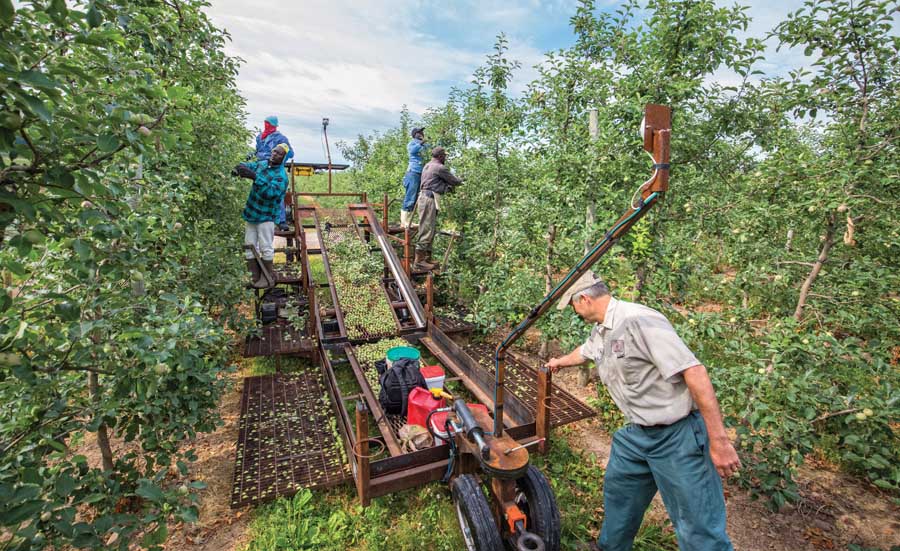
Paul Wafler, right, adjusts the speed on a Huron Fruit Systems mechanical platforms as crews thin TST system tree rows at Wafler Farms in Wayne County, New York on July 1, 2016. (TJ Mullinax/Good Fruit Grower)
Paul Wafler farms 1,100 acres in Wayne County, New York, including 450 acres of apples — producing 400,000 bushels annually — with one-third of their acreage nonbearing.
Paul and brother Walter, president of their Huron Fruit System firm, design and build orchard equipment — something that’s been a lifelong obsession for Paul.
He tinkered with machines as a youngster and, in his early teens, began fixing lawn mowers.
He became so enthralled with machines and how they worked, he filled the family’s basement with his projects.
These days, the Waflers build and sell machines that are designed to improve orchard worker efficiency, including a two-row hedger that cuts time spent at the task by half, significantly reducing costs.
The crown jewel of their company is a two-piece package consisting of a self-propelled, mobile platform and an automated bin loader.
Paul Wafler said it provides a 30 to 50 percent efficiency boost in clean picks and doubles efficiency in spot picking.
Workers generally fill five bins in about 45 minutes to an hour, depending on picking quality and fruit size, and the farm has eliminated the use of ladders.
The platforms are assembled from precut steel, sent out for painting and returned to be equipped with motors and hydraulics.
Finished platforms feature an inclined central track with rollers on both sides, where the bins are situated.
Six worker platforms, three on either side at three different heights, extend upward alongside the bin rack, enabling crews to pick fruit, prune, thin or tie trees.
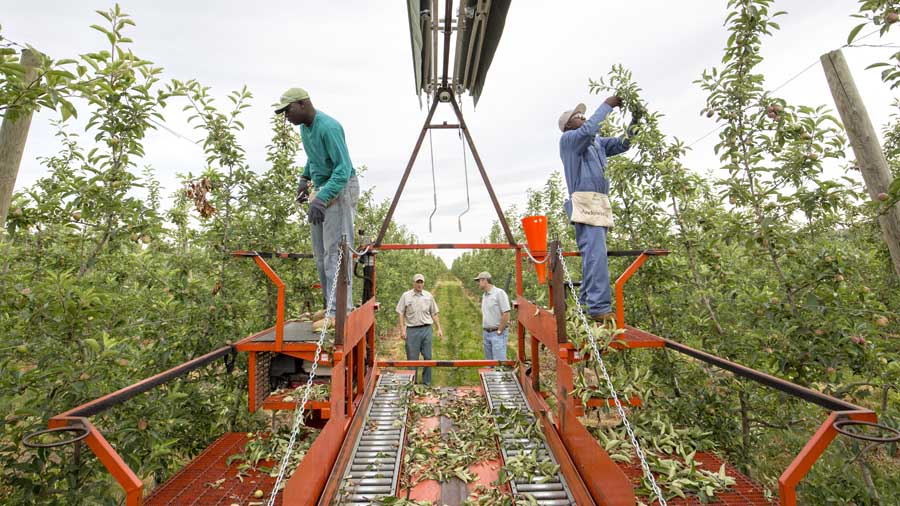
Baswell Henry, left and Greg Barnett, thins apples from one of several Huron Fruit Systems mechanical platforms working TST system tree rows. Paul Wafler, center left, and Walter Wafler talk in the background. (TJ Mullinax/Good Fruit Grower)
Metal hoops, four on each side, extend just beyond the worker platforms to hold inverted traffic cones. The cones can be used to hold gear during nonharvest tasks or, during harvest, to hold culls and bruised fruit.
“We pay our workers the same rate for quality fruit and culls,” Walter Wafler said. “That way they won’t game the system, putting culls in the quality bins. By not throwing them on the ground, they increase revenue.”
When the cones fill, they are emptied into a single wooden or plastic bin in the middle of the platform.
Workers fill the two bins below and above the cull bin with quality fruit.
When the bins are ready to be replaced, a tractor-hitched bin trailer, another Wafler innovation, raises five empty bins off the ground and places them on an elevated trailing rack behind the platform.
The platform rack with the full bins tips downward, allowing those bins to exit to the ground under the storage trailer. The empty bins on the elevated rack then load onto the platform rack and are raised to the pick position.
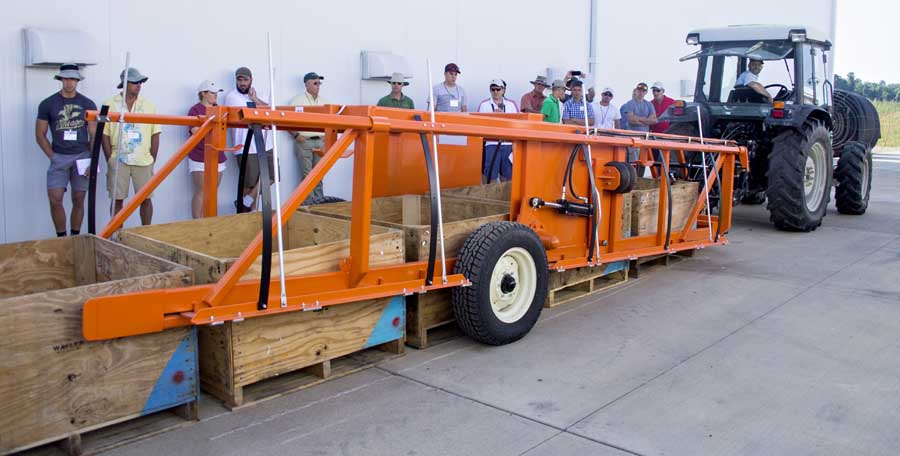
The Wafler designed bin loader presented during the 2016 IFTA New York Tour. (Shannon Dininny/Good Fruit Grower)
One bin loader can serve up to four platforms at a time, and platform workers keep picking throughout the bin exchange.
The self-propelled platform can be controlled from seven positions — a control panel located at the rear as well from six posts, three on each side, equipped with toggles for steering and speed adjustments.
A $3,000 video-monitoring system tracks the platform progress, location, yields and worker performance, allowing for pickers to review their efforts and improve efficiency.
VanDeWalle
Another mechanical innovation comes from Scott VanDeWalle of Alton, New York. He designed a multirow pruning platform that runs almost every day, except during harvest, for a wide array of orchard tasks, including winter pruning, summer suckering, hand-thinning and tying trees.
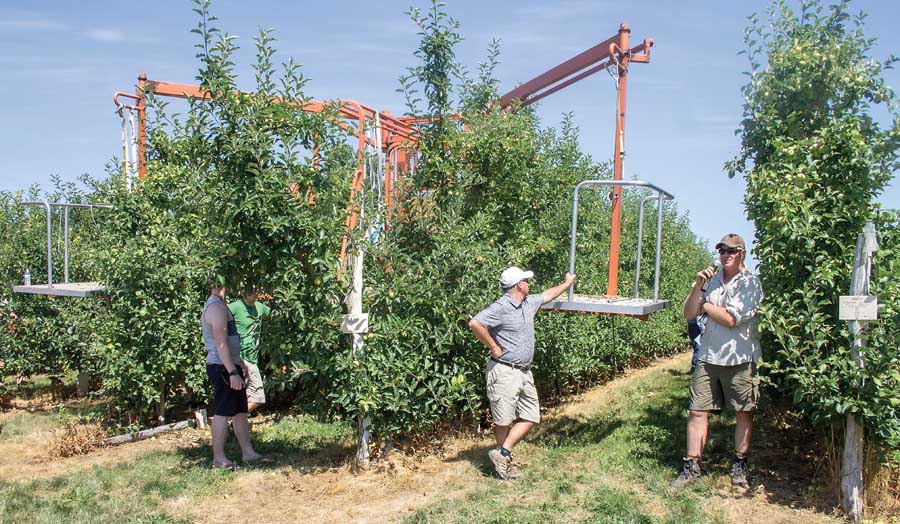
Scott VanDeWalle, right, designed a multirow pruning platform that runs almost every day, except during harvest, for a wide array of orchard tasks, including winter pruning, summer suckering, hand-thinning and tying trees. Shannon Dininny/Good Fruit Grower
The structure is mounted atop a tractor with an inner platform and two outer platforms hung on metal arms from the center of the machine in a gull-wing arrangement.
The outer platforms hold one worker each while the central platform holds one worker on each side, plus a driver in the front.
The driver raises, lowers and extends the outer platforms and steers the vehicle with a self-centering joystick.
“We tried using a radar- or sonar-based steering system, but we could never get it to work,” VanDeWalle said.
Next to steering, maintaining proper speed is the key to efficient platform use.
“Speed has to vary, depending on how heavy the canopies are and whether crews are pruning or thinning,” he said. “Proper speed is necessary so the guys aren’t standing around looking at each other.”
Trees are 10.5 to 11 feet tall. VanDeWalle uses a five-wire system and supports it with 12-foot poles. The lowest wire is 2 feet above ground and the highest is at 9.5 feet.
The outer platforms can be raised from 12 to 13 feet above ground level and extended outward 12 feet from the central platform. Central platform workers focus efforts from the second wire to the tops.
Those on the outside handle the rest. “Our workers can cut four rows at a time as long as they can reach through,” he said.
Woodworth
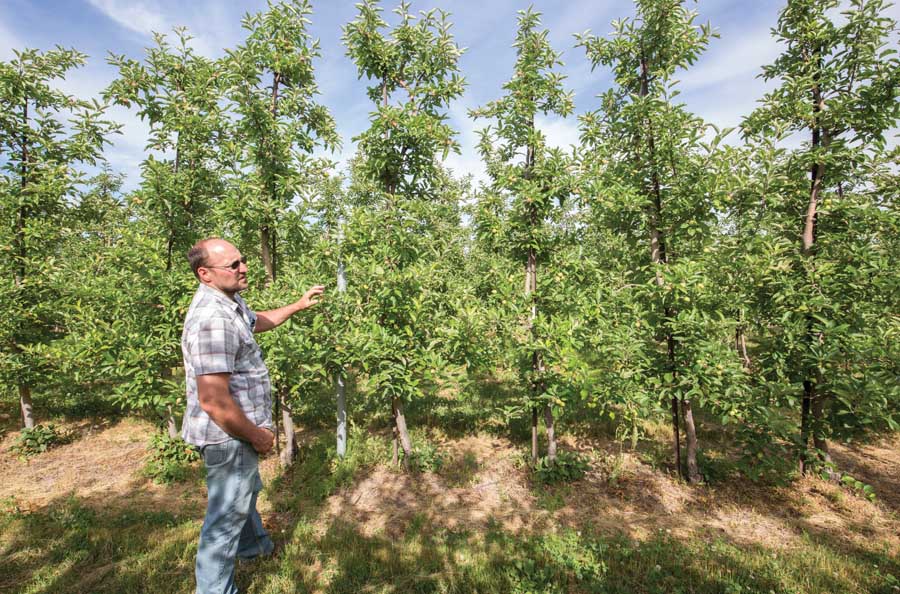
Patrick Woodworth shows a 13-foot-tall vertical axis system that took about four to five years grow into a fruiting wall to better accommodate mechanization at Sandy Knoll Farms near Lyndonville, New York. Each tree uses a single piece of steel to help it remain self-supporting, which makes a trellis system unnecessary. (TJ Mullinax/Good Fruit Grower)
Another grower using mechanical innovations is Patrick Woodworth of Sandy Knoll Farms near Lyndonville, New York.
He began transitioning his old-style, central leader Gala blocks into a tall spindle system in 2015. The trees are planted on Malling 9 rootstocks with 3.5 feet between trees and 14 feet between rows.
Woodworth is looking for more sunlight interception and greater labor efficiency as he moves to adopt the tall spindle system.
“We want to push production closer to the trunk. Our transition sets the stage for mechanical aid in orchard maintenance and harvesting,” he said.
To get those improvements, Woodworth uses a mechanical hedger and an automated platform built by J.J. Dagorett’s Automated Ag Systems of Moses Lake, Washington. “I can’t say enough about how necessary this platform is to our operation,” he said.
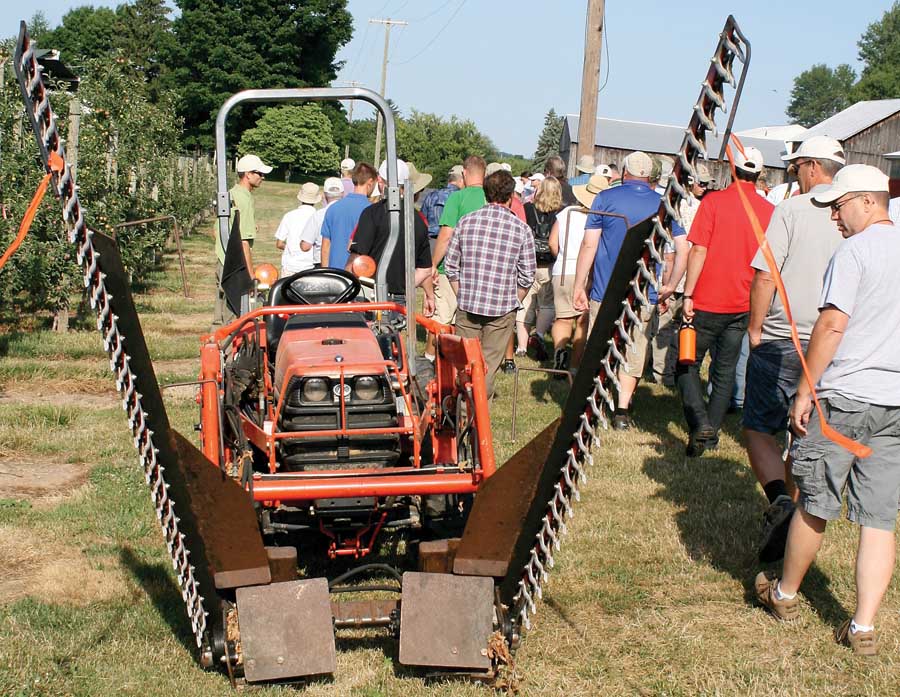
A two-row hedger, designed and built by Paul and Walter Wafler to run down their 7-foot rows between their tall spindle tipped trees, is able to hedge two rows at a time. The machine cuts labor time and costs in half for this task. Dave Weinstock/Good Fruit Grower
It’s a popular piece of equipment in the region.
Dagorett sold the same platform to Rod Farrow of Lamont Farms of Waterport, New York, and two more New York growers are getting the same machine before the Gala and Honeycrisp harvest, said Mario Miranda Sazo, a Cornell Cooperative Extension Service Lake Ontario Fruit Program fruit specialist.
Woodworth’s farm previously had 888 trees per acre. That has increased to 1,980 trees per acre in 2-by-11 spacing for new plantings.
New plantings also are going in on five- and six-wire systems, compared with the single-wire system in existing blocks, where a pole supports each tree.

Steel angle iron supports for Woodworth’s Sandy Knoll Farm fruiting wall. (TJ Mullinax/Good Fruit Grower)
Existing tree growth ranges from 12 to 14 feet high, with branches at 20 to 24 inches and bearing fruit within 18 inches of the tops.
Ultimately, his trees will be square-shaped; they will “set the box” with a 44-inch width.
“With that dimension, our workers — who pick from platforms — can get to tree centers without the hindrance of dominant branches,” Woodworth said.
In the first three years, his crews perform dormant pruning to remove dominant branches. He limits renewal cuts to three per tree.
“Three cuts is a rule of thumb,” Woodworth said. “It’s a stopgap for the pruners, which, if we do it this way consistently, allows us to keep the tree calm and helps to equalize its crop load every year.”
Hedging makes the point of regrowth at the same spot, away from the trunk. “We are limiting the opportunity for the tree to grow out and creating more opportunity for it to fill in empty spaces at our desired dimension,” he said.
They do the same hand-pruning in the fourth year but follow with mechanical pruning at dormancy, to set the box at 20 to 22 inches from the trunk.
New shoots grow the following season and are hedged 22 to 24 inches from the trunk in late summer. •
– by Dave Weinstock






Leave A Comment